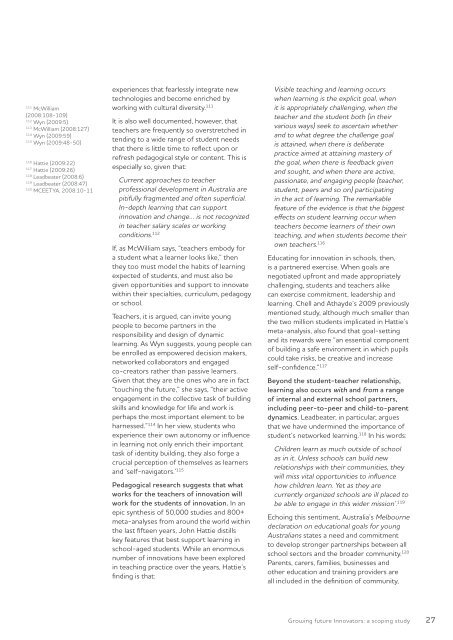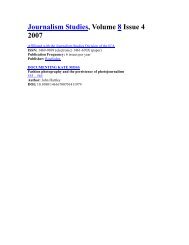GrowinG Future innovators - ARC Centre of Excellence for Creative ...
GrowinG Future innovators - ARC Centre of Excellence for Creative ...
GrowinG Future innovators - ARC Centre of Excellence for Creative ...
Create successful ePaper yourself
Turn your PDF publications into a flip-book with our unique Google optimized e-Paper software.
111 McWilliam<br />
(2008:108-109)<br />
112 Wyn (2009:5)<br />
113 McWilliam (2008:127)<br />
114 Wyn (2009:59)<br />
115 Wyn (2009:48-50)<br />
116 Hattie (2009:22)<br />
117 Hattie (2009:26)<br />
118 Leadbeater (2008:6)<br />
119 Leadbeater (2008:47)<br />
120 MCEETYA, 2008:10-11<br />
experiences that fearlessly integrate new<br />
technologies and become enriched by<br />
working with cultural diversity. 111<br />
It is also well documented, however, that<br />
teachers are frequently so overstretched in<br />
tending to a wide range <strong>of</strong> student needs<br />
that there is little time to reflect upon or<br />
refresh pedagogical style or content. This is<br />
especially so, given that:<br />
Current approaches to teacher<br />
pr<strong>of</strong>essional development in Australia are<br />
pitifully fragmented and <strong>of</strong>ten superficial.<br />
In-depth learning that can support<br />
innovation and change… is not recognized<br />
in teacher salary scales or working<br />
conditions. 112<br />
If, as McWilliam says, “teachers embody <strong>for</strong><br />
a student what a learner looks like,” then<br />
they too must model the habits <strong>of</strong> learning<br />
expected <strong>of</strong> students, and must also be<br />
given opportunities and support to innovate<br />
within their specialties, curriculum, pedagogy<br />
or school.<br />
Teachers, it is argued, can invite young<br />
people to become partners in the<br />
responsibility and design <strong>of</strong> dynamic<br />
learning. As Wyn suggests, young people can<br />
be enrolled as empowered decision makers,<br />
networked collaborators and engaged<br />
co-creators rather than passive learners.<br />
Given that they are the ones who are in fact<br />
“touching the future,” she says, “their active<br />
engagement in the collective task <strong>of</strong> building<br />
skills and knowledge <strong>for</strong> life and work is<br />
perhaps the most important element to be<br />
harnessed.” 114 In her view, students who<br />
experience their own autonomy or influence<br />
in learning not only enrich their important<br />
task <strong>of</strong> identity building, they also <strong>for</strong>ge a<br />
crucial perception <strong>of</strong> themselves as learners<br />
and ‘self-navigators.’ 115<br />
Pedagogical research suggests that what<br />
works <strong>for</strong> the teachers <strong>of</strong> innovation will<br />
work <strong>for</strong> the students <strong>of</strong> innovation. In an<br />
epic synthesis <strong>of</strong> 50,000 studies and 800+<br />
meta-analyses from around the world within<br />
the last fifteen years, John Hattie distills<br />
key features that best support learning in<br />
school-aged students. While an enormous<br />
number <strong>of</strong> innovations have been explored<br />
in teaching practice over the years, Hattie’s<br />
finding is that:<br />
Visible teaching and learning occurs<br />
when learning is the explicit goal, when<br />
it is appropriately challenging, when the<br />
teacher and the student both (in their<br />
various ways) seek to ascertain whether<br />
and to what degree the challenge goal<br />
is attained, when there is deliberate<br />
practice aimed at attaining mastery <strong>of</strong><br />
the goal, when there is feedback given<br />
and sought, and when there are active,<br />
passionate, and engaging people (teacher,<br />
student, peers and so on) participating<br />
in the act <strong>of</strong> learning. The remarkable<br />
feature <strong>of</strong> the evidence is that the biggest<br />
effects on student learning occur when<br />
teachers become learners <strong>of</strong> their own<br />
teaching, and when students become their<br />
own teachers. 116<br />
Educating <strong>for</strong> innovation in schools, then,<br />
is a partnered exercise. When goals are<br />
negotiated upfront and made appropriately<br />
challenging, students and teachers alike<br />
can exercise commitment, leadership and<br />
learning. Chell and Athayde’s 2009 previously<br />
mentioned study, although much smaller than<br />
the two million students implicated in Hattie’s<br />
meta-analysis, also found that goal-setting<br />
and its rewards were “an essential component<br />
<strong>of</strong> building a safe environment in which pupils<br />
could take risks, be creative and increase<br />
self-confidence.” 117<br />
Beyond the student-teacher relationship,<br />
learning also occurs with and from a range<br />
<strong>of</strong> internal and external school partners,<br />
including peer-to-peer and child-to-parent<br />
dynamics. Leadbeater, in particular, argues<br />
that we have undermined the importance <strong>of</strong><br />
student’s networked learning. 118 In his words:<br />
Children learn as much outside <strong>of</strong> school<br />
as in it. Unless schools can build new<br />
relationships with their communities, they<br />
will miss vital opportunities to influence<br />
how children learn. Yet as they are<br />
currently organized schools are ill placed to<br />
be able to engage in this wider mission’. 119<br />
Echoing this sentiment, Australia’s Melbourne<br />
declaration on educational goals <strong>for</strong> young<br />
Australians states a need and commitment<br />
to develop stronger partnerships between all<br />
school sectors and the broader community. 120<br />
Parents, carers, families, businesses and<br />
other education and training providers are<br />
all included in the definition <strong>of</strong> community,<br />
Growing future Innovators: a scoping study 27




![Plebiscite (Riegert chapter) revised FINAL [Feb 14].pdf](https://img.yumpu.com/8710373/1/190x245/plebiscite-riegert-chapter-revised-final-feb-14pdf.jpg?quality=85)